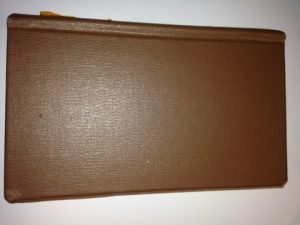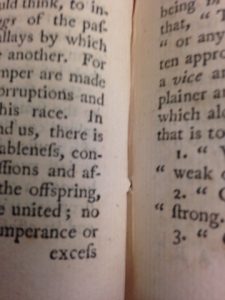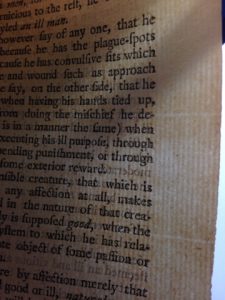In our 5th assignment we were asked to explore the world of social networking maps. Above is my recreation of Dr. Pauley’s selected data of books and borrower’s of Manchester Academy from January to December of 1845 for better or for worse. Enjoy!
Category: Uncategorized
The Curious Case of the Unaccounted for Baskerville
You can imagine that along with the introduction of new research tools one would quickly pick their favorites. This tool has proved to not be included in that short list. After searching through the English Short Title Catalogue, I found 15 entries for Characteristicks by Anthony Ashley Cooper. However, curiously enough, I did not find the entry for the book located at my college which was printed in Birmingham, Alabama. This was exciting news! I plan to further investigate the origin of this book with our archivists in order to explore the curious case of the unaccounted for Baskerville further. Below, I have embedded the map displaying the locations that have known published versions of the book that the English Short Title Catalogue knows about.
Assignment #3 Timeline JS
In the link above I have provided a Timeline JS for Interpretations of Journalism by Frank Luther Mott and Ralph D. Casey. This book was published in 1937. Although it is fairly new by our terms of printing format and age, I chose this book because it was chalk full of provenance. It seems to me that this book was used in a class for a research project or possibly used a text book/recommended reading source. The basis for this assumption comes from the type of provenance found inside. Another interesting point to keep in mind when reviewing this book and Timeline is that all provenance throughout the book is written in the same handwriting. I assume receiving this book as an upcoming jounalism student must have felt like Harry Potter did when discovering the Half Blood Prince’s potions textbook. Multiple paragraphs and passages are underlined, questioned, noted on, referenced, and checked off in a manner of possible approval or merely checking off a paragraph as a task would be on a to-do list. This book is signed by W. L. Wilson, on whom I could find no genealogical information. There is also a wonderful passage of questions written on the last leaf of the book that comes off to the reader (myself) as an afterthought upon reading the book.
Bailey
A Hypothesis for the Physical History of Characteristics Vol II
The book I chose to analyze for bibliographic content was Characteristics Vol II: An Inquiry Concerning Virtue and Merit by Anthony Ashley Shaftesbury. Upon analyzing the book at first glance it was obvious to me that this book had been rebound since it had a nice shiny cover. However, what turned out to be interesting was that upon looking in the gutter of the book there was clear signs of prior sewing that was still intact. The sewing method did not appear to be stab stitching. The margins of the rebound book were quite small (especially the inner margin). Another interesting point to make about the type of paper used in creating this book would be the visible brown pulp on the pages. The pages of the book seem to have been kept in good conditions because there is no visible sign or smell of mold or rot.
The book was made with laid paper as indicated with the visible chain and wire lines. The chain lines are running horizontally while the wire lines are running vertically. All pages are opened in this case as the book has been previously trimmed. Therefore, there are no deckle edges. Regarding the signatures of the book, it appears to be marked with a letter beginning wit “A” and continuing to “A 3” before three blank leaves follow. The signature then starts over and begins with “B” in the same pattern. There were not any visible watermarks viewed in the book. However, this does not mean that there was not once a watermark on the pages (keep in mind the pages with trimmed tightly to the text block).
From this information, I hypothesize that this book was printed in the format of quarto. This book has 336 pages and 168 leaves. If a quarto format produces 4 leaves of paper, then this would mean that this book was created from 42 sheets of laid paper.



Journey Into the Archives: The Beginning
Upon meeting with the archivists of the University of Virginia’s College at Wise, I learned many interesting things. One of these newfound facts was that there is a long journey ahead of me. With all of the resources that are available, you can imagine that beginning an archival research project on the history of the social life of books of Appalachia is like confronting the Leviathan. However, being the proud Appalachian that I am, I am ecstatic to embark on this journey and further connect myself with the history of what I am honored to call home. The Appalachian Mountains, being one of the oldest mountain ranges on the planet, has an extremely deep and rich culture and history.
It came to my knowledge through the help of our archivists that the oldest book in our library the philosophical work known as Characteristicks of Men, Manners, Opinions, Times by Anthony Ashley Cooper, Earl of Shaftesbury. This work was first published in 1714 (Volume III), although the copy I have in my hands is a reprinted version from 1958 that was printed by J. Baskerville in Birmingham, Alabama. According to our senior archivist, the owner of this set before it came into the hands of the college is unknown. As far as the history of this work goes, it turns out that Cooper, the grandson of the first earl, was an English politician with a taste for neoplatonic philosophy as is revealed in this book (The Editors of Encyclopædia Britannica). It is thought that this famous 18th century philosopher and student of John Locke created this exploration of moral sense in response to another great philosopher of the same time, Thomas Hobbes. According to McAteer, Anthony Ashley Cooper’s style of writing affects the reader’s moral sense in a positive way rather than simple speculation (McAteer).
On another note, a specific collection in our library that I am particularly interested in exploring is the James Taylor Adams collection. James Taylor Adams was a faithful patron to the Appalachian literary world. A jack of all trades, Adams served and worked as a writer, newspaper editor, historian, Post Master, and merchant. He lived in an area known as Stephens of Wise, Virginia. Adams diligently created a collection of Appalachian folklore and folk songs along with historical records of Wise County. There are also many works of local genealogy in the collection. The college came by this wonderful collection of local history over forty years ago through the gracious donation of the Adams family after the passing of James Taylor Adams.
The final interesting subject that was explored was finding a text that showed signs of use. This was found in the Gladys Stallard collection which consisted of local literature and genealogy records. Gladys corrected books in pen and highlights people she knew with a marker. She also signed all of her books indicating her possession. One of the books that this was observed in multiple times was Godspeed’s History of Hamilton, Knox, and Shelby Counties of Tennessee. I realize that this may not even be scraping the surface of the tasks I have before me, but it is a start.
Bailey Curtlan Helbert
The University of Virginia’s College at Wise, 2017
Department of Natural Sciences
Biochemistry
This post was derived from material in the Editors of Encyclopedia Britannica, Anthony Ashley Cooper, 3rd Earl of Shaftesbury | English Politician and Philosopher [1671-1713] and John McAteer, The Third Earl of Shaftesbury (1671—1713).